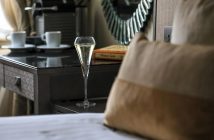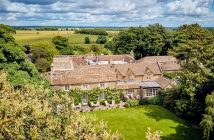Castle Combe in Wiltshire, home to The Manor House Hotel, is a beautiful and historic village which has been the setting of countless TV and film productions, most recently Stephen Speilberg’s War Horse. The pretty church of St Andrew’s houses one of the oldest clocks in the country, a tea room delights passing visitors in search of old England, and an unmanned cake stall (complete with a poster boasting of having served Hollywood’s elite) is run on honesty payments collected once a day. Check-in not being until 3pm, we finished our tour with a visit to the Castle Inn (the less pretentious sister property of The Manor House) where we enjoyed a pub lunch of doorstop sandwiches and local ale, and basked in the atmosphere of this film-set good-looking country idyll.
Despite it not being our first stay at The Manor House, (or perhaps because of it) I couldn’t help but feel a thrill of excitement as we cruised down the sweeping drive, where a portion of the River Bybrook makes for a pretty picture indeed. Daffodils and early bluebells heralded the fast approaching days of spring and summer when the empty lawns would once again be filled with golfers making their way to the hotel’s championship 18 hole course, walkers exploring a portion of the 365 acre estate, brides and grooms posing for photographs on the best day of their lives, spoiled afternoon tea goers trying to resist another cake, and laughing children amusing themselves with the croquet and over-sized chess set. Such was the atmosphere on our last visit, whereas the quiet weekday in mid-March offered up an altogether more serene experience, no less enjoyable.

Marsh Furlong
Having previously stayed in the main building, dating from the 14th century, it was delightful to be shown to the Marsh Furlong suite, located at the end of a beautiful row of Cotswold stone Mews cottages adjacent to the hotel and opposite the church. Who needs mobile phone reception when you have oozing country charm and beams, not to mention accommodation that is handily placed for the Castle Inn just outside the gate? Marsh Furlong features it’s own garden with seating area, perfect for the summer months, while inside a log burning stove is a welcome sight come winter. A comfortable king size bed, roll top bath complete with aqua TV for bath-time viewing, supersonic Dyson hairdryer to help you look your best, and a tablet listing hotel and room services make it extremely plush, while the half bottle of Tattinger and handmade hazelnut and chocolate macarons awaiting us was an extremely thoughtful gesture to mark my husband’s birthday.
Everything was the last word, and on the surface nothing much appeared to have changed since our last stay, save the departure of Executive Chef Richard Davies who, after eight and a half years at the helm, announced that he was leaving at the end of 2015. It was certainly the biggest shake up The Manor House have experienced in some time, for whoever was appointed to replace him had the enormous pressure of retaining The Bybrook restaurant’s prized Michelin star. And it was clear to see from first entering the restaurant that Robert Potter, who previously worked at Lucknam Park under executive chef Hywel Jones, has spent his first year at the Manor House, putting his own mark on things. The menus sounded lighter, while the dining room feels more informal due to table linens having been banished in favour of on-trend wooden tables and woodblock cutlery holders.

The Bybrook
Some come to The Manor House for the golf, some for the 160 different brands of gin available in the Full Glass Bar, while others come for the food, and the tasting menu was a great opportunity to experience Potter’s own style of cuisine. A wonderfully soft confit of Loch Duart salmon opened proceedings, paired with traditional bedfellows, beetroot and horseradish, although in this case the beetroot had been marinated rather than cooked and therefore offered plenty of texture, while the horseradish mousse was delicate and subtle in flavour, and the chilled sparkling rosé by Nyetimber had just the right notes of acidic red berries. The Foie Gras torchon that followed felt as decadent as the opener had seemed virtuous, with a golden raisin purée and sweet wine jelly proving a fine homage to classical French techniques and flavours. The accompanying date and walnut toast and Sauternes (just another of many superb wine pairings), were the perfect finishing touches.
Potter’s style is all about light and shade, so the first of the main dishes, braised Gigha halibut with samphire, cockles, mussels, and a chive beurre blanc, succeeded in being demure and feminine, yet with just enough buttery richness and salty seaside nostalgia about it to be entirely absorbing. One of my favourite ingredients followed, Salisbury Plain fallow deer, cooked to perfection; a soft medium-rare loin enhanced by an intensely gamey faggot, parsnip purée, sprouts (I would have appreciated more than three halves), an al dente length of salsify topped with bacon bits and a glossy, blood red sloe gin jus which went a treat with the Sardinian, Tancca Farra, bursting with woodland berries and hints of mocha.

Desserts (it’s always good to have two) were refreshing rather than rich, in a break from the light and shade previously adopted in an attempt to ease guests through the numerous courses. Another of my favourite ingredients, Yorkshire rhubarb, was celebrated by being gently poached and contrasted with a tangy whipped yoghurt and rhubarb and ginger ale granita which gave a fizzy tingle on the tongue; while the summery finale was an intense and buttery lemon-curd style Amalfi lemon tart topped with a brûlée-inspired caramel shard and partnered with Bruce farm raspberries, raspberry jelly, baby basil and a vibrant, silky, raspberry sorbet. The dessert wine choice of Jurancon was a match made in heaven due to its sweet yet citric notes reminiscent of warm, sun-drenched lemon groves in the South of France. A fine ending to a fine meal, I’m pleased to report that The Bybrook remains an essential part of staying here.
It never ceases to amaze me how you can wake up feeling hungry after a meal like that, yet there we have it, and after a hearty breakfast the next morning we decided to explore the local area (and walk off some of the calories). The Manor House is ideally placed for a day out in Bath, but as we live there we decided to venture further afield. Exchanging one charming village for many others, we took a scenic journey northwards through Acton Turville and Badminton in Gloucestershire, before arriving at the Rococo Garden in Painswick just before lunch.

Painswick Rococo Garden
A jewel of an English pleasure garden designed for the wealthy Hyett family in the 1740s and taking inspiration from fashionable and highly theatrical European examples of the day, it features a variety of quirky architectural follies, a vegetable garden, a maze and, come early spring, glades of snowdrops in which to lose yourself. Lovingly preserved using only authentic plant varieties, this breathtaking garden offers a unique insight into well-to-do 18th century life, when gardens like this were as much, if not more, about surprise, wonder and entertainment as they were about horticulture. The village of Painswick is also well worth pausing at, while if you’re looking for a scenic route back to The Manor House go via Tetbury where its antiques shops will delight foragers, and, if you still have the energy, a walk around Westonbirt Arboretum is spectacular at any time of year. On the other hand you may just want to spend the entire day at the hotel sipping gin, and frankly who could blame you?
The Manor House, an Exclusive Hotel and Golf Club, Castle Combe, Wiltshire SN14 7HR. For more information and to make a booking please visit the website.




